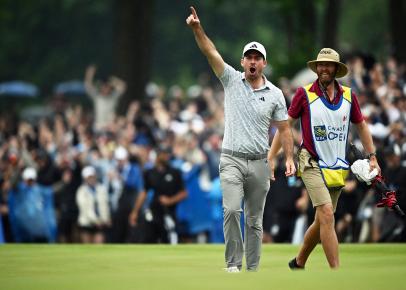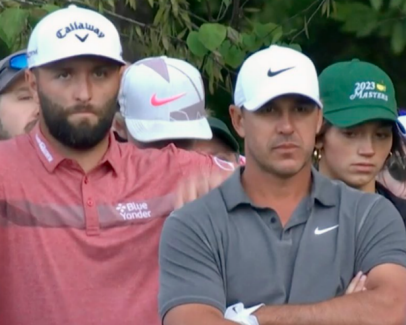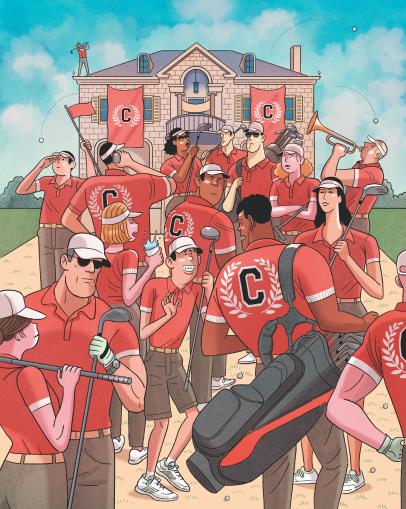Year in Review
2023 Newsmakers of the Year
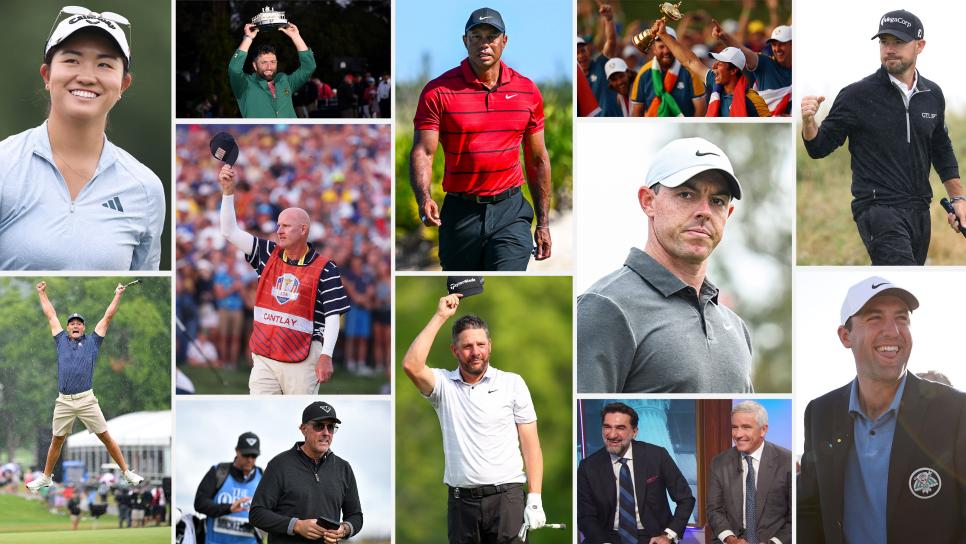
There was an expectation in some circles that 2023 would see golf settle into its new normal. A rival upstart to challenge the PGA Tour was no longer a threat but a reality, LIV Golf disrupting the game’s ecosystem on the course and in the courtroom. To counter, Ponte Vedra Beach launched a “designated events” defense, throwing its millions at LIV’s billions. Thankfully, the enemies looked more like frenemies when they shared the stage at the Masters (almost won by a LIV golfer) and the PGA Championship (actually won by a LIV golfer).
And then June 6 happened, with Jay Monahan and Yasir Al-Rumayyan sharing the screen on CNBC as if the two men were former college roommates reunited rather than bitter rivals. Suddenly, up was down, down was out and the new normal was papered over by something called a “framework agreement.”
As 2023 winds down, it feels like there is so much more in store. But before the final chapter is written, it’s worth remembering what transpired in the previous pages. Once more, we do so by counting down the top 25 Newsmakers of the Year, returning to the individuals, teams, tournaments and topics that defined the last 12 months. Our list is a hopeful reminder that the year wasn’t all gossip and Congressional hearings. There were moments of levity (the emergence of Michael Block) and moments of inspiration (the emergence Rose Zhang and Lilia Vu) and moments of golfiness (the return of the Ryder Cup). All have their own compelling stories. —Ryan Herrington
No. 1: The Framework Agreement
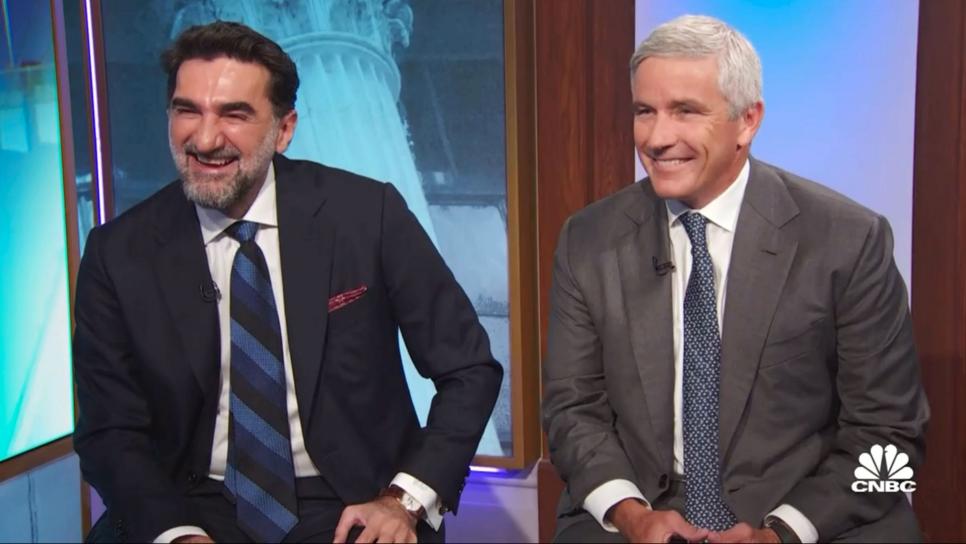
The weeks before major championships are usually quiet. But days before the golf world congregated in Los Angeles for the U.S. Open, the PGA Tour and LIV Golf’s financial backer, Saudi Arabia’s Public Investment Fund, announced a surprise treaty and potential merger (that both sides would later insist was not a merger) that would theoretically end two years of civil war in professional golf. “Theoretically” is the operative word, as nearly six months later, that detente could now fall apart.
On the morning of June 6, PGA Tour commissioner Jay Monahan and PIF governor Yasir Al-Rumayyan appeared together on CNBC, a scene almost as surreal as its backdrop, the duo making public that their respective organizations (along with the DP World Tour) had come to a “framework agreement” that would unify the professional game on a global basis. The agreement was scant on details (more on this in a moment), except to note that the PIF would be combining its “golf-related commercial businesses and rights (including LIV Golf) with the commercial businesses and rights of the PGA Tour and DP World Tour into a new, collectively owned, for-profit entity to ensure that all stakeholders benefit from a model that delivers maximum excitement and competition among the game’s best players.” In addition to the financial investment in the new entity for an equity stake, the PIF would become a premier corporate sponsor of the PGA Tour, DP World Tour and other international tours. Monahan said PIF's investments would allow them to "build an even stronger and more robust commercial business, together.” Perhaps most notably, there was a provision in that deal that called for all pending litigation between the tour and PIF to be dropped within 10 days, a godsend for each party; sources tell Golf Digest the tour was struggling with the financial burden of the mounting legal fees, while PIF had lost a series of early court battles, including a decision in which Al-Rumayyan and PIF were found not to be protected by immunity law from producing documents and being deposed.
While the initial shock of the news was stunning—two seemingly bitter enemies suddenly becoming allies—the fallout from how it all came about would radiate for months to come. Given the emotional and existential weight caused by golf’s schism, the secret nature of the deal did not go over well. Numerous PGA Tour players expressed their frustration with being kept in the dark, to say nothing about the alleged hypocrisy of the deal, the tour taking the very money it had told its membership not to take. Rory McIlroy, who had been the de facto face of the tour’s battle in the absence of leadership, admitted he felt like a “sacrificial lamb.” A group of 41 players later wrote Monahan requesting a number of new measures—including the addition of Tiger Woods on the policy board—to ensure transparency during the negotiations. Adding to the turbulence was the temporary departure of Monahan, who suffered a health scare that required him to step away from his position for nearly a month.
Also upset were leaders of Congress, who the tour had tried to enlist in its fight with LIV. According to Senator Richard Blumenthal (D-Conn.) the deal raised “concerns about the Saudi government’s role in influencing this effort and the risks posed by a foreign government entity assuming control over a cherished American institution.” Blumenthal threatened that the alliance could be reviewed by the Committee on Foreign Investment in the United States, which analyzes mergers regarding potential threats to the nation’s security. A month later, a Congressional hearing was held on the framework agreement, a circus act that revealed little of substance.
However, to appease potential antitrust regulations, the tour also sought additional private equity funding for the new for-profit enterprise. Despite promises of transparency the negotiations remained private to most tour members, and the process somewhat sidetracked the tour’s negotiations with PIF, with multiple reports in late summer and fall detailing the discussions as stalled. Perhaps sensing the deal was in jeopardy, PIF responded in December by signing reigning Masters champ Jon Rahm to LIV Golf. Though the move could accelerate a potential agreement, there are those in the PGA Tour’s camp who see it as an act of war.
As of writing, no final deal has been announced between the PGA Tour and PIF, with a Dec. 31 deadline drawing near (albeit a deadline that both sides can extend). There is a chance there is peace in professional golf by the end of the year. There’s also the chance both sides become as emboldened as ever in their positions. Unfortunately for golf fans, the lesson of 2022 and 2023 remains the same heading into 2024: Professional golf’s schism will continue to be cloaked in smoke and the haze isn’t clearing anytime soon. —Joel Beall
No. 2: The Ryder Cup at Marco Simone
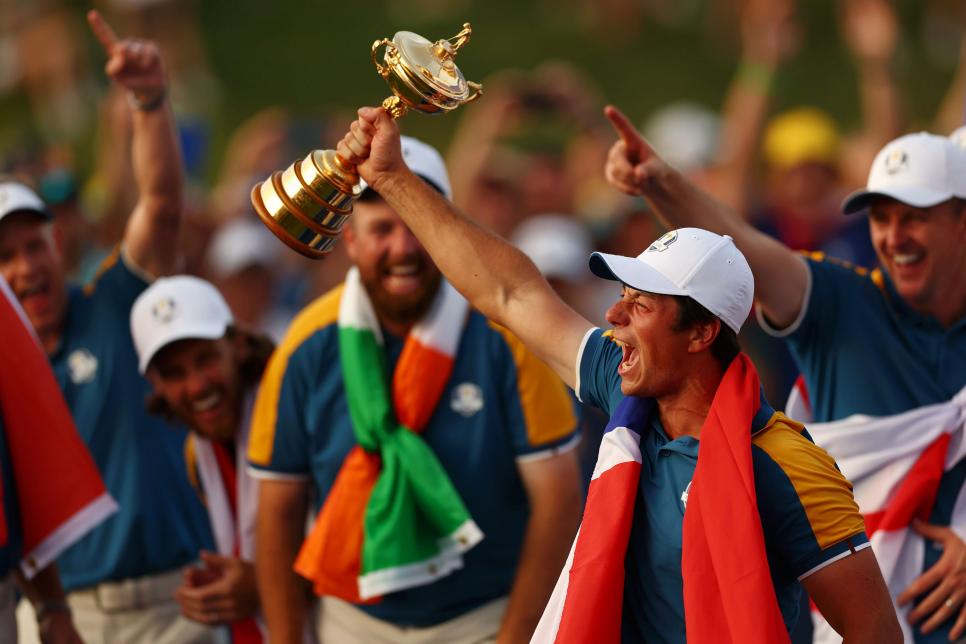
There is no greater spectacle in golf than the Ryder Cup, but that word, "spectacle," can take on wildly different meanings. This year, in Italy, the spectacle was initially anticlimactic, briefly confounding and finally electrifying. More than all that, it was—there's no better word—ridiculous. With the distance of two months, we can safely say that Rome was the strangest Ryder Cup of our lifetimes.
Mind you, the final score, Europe 16½, the U.S. 11½, didn't seem strange at all. Predictably, rather, the home team won in a blowout just as it had for the last four editions of the biennial match. We can't ignore the hard reality that it's been more than a decade since we've seen a competitive Ryder Cup, and this one was over almost before it began when Europe ran up a 4-0 lead in the very first foursomes session that proved insurmountable, despite some false tension on Sunday afternoon. Afterward, the usual dysfunction presented itself on the losing American side, rumors of illness and all kinds of internal strife. U.S. captain Zach Johnson took hit after hit while Europe’s Luke Donald was so revered that they already locked him up for Bethpage in 2025. Still, the net result is that from a outcome standpoint, the Ryder Cup has come to look so predictable that it risks hurting the exhibition’s stature.
Get away from the score, though, and Rome was an absolute circus. We'll never forget "Hatgate," when it was reported (perhaps wrongly—we still don't quite know) that Patrick Cantlay was staging a silent protest at not being paid for his participation by going hatless … which unleashed tens of thousands of Euro fans on him … which led to the bizarre incident Saturday afternoon when his caddie Joe LaCava, boiling with rage after what must have been a very long day, reacted to a match-winning Cantlay putt by taunting the crowd and hindering Rory McIlroy's putting routine … which prompted a shouting match that carried on to the parking lot afterward, when McIlroy let loose rather randomly on Bones Mackay—the first American he saw after from the locker room.
That tension grew over night and spilled into Sunday singles, when a few American wins made the outcome look briefly uncertain until it wasn’t. Once again, the Ryder Cup proved yet that even in a blowout, it can never be anything less than a melodrama. An illustrative point: When a hospitality tent burned to the ground a few days after the event was over, it barely raised an eyebrow … it wasn't even close to the weirdest thing we had seen at Marco Simone. —Shane Ryan
No. 3: Jay Monahan
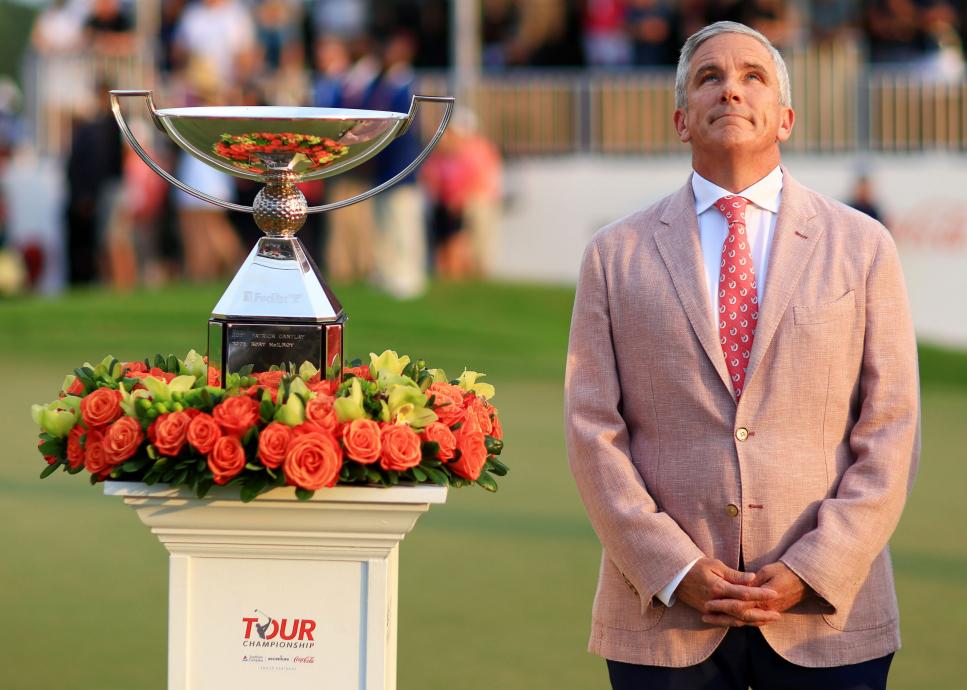
His counterparts at America’s major team-sports leagues have to manage the whims of billionaire owners, but at least there are only a few dozen to be attended to. By contrast, PGA Tour commissioner Jay Monahan is beholden to some 200-plus stakeholders with their own a variety of self-serving interests. There’s a lot of pressure, which has ratcheted to withering degrees in the last 18 months with the direct existential challenge to the tour from the LIV Golf League. A series of moves (designated events, Player Impact Program, Earnings Assurance Program) creakily stemmed the tide of defections, but not all of them were universally applauded. And then came June 6, when Monahan announced a framework agreement with Yasir Al-Rumayyan of the Public Investment Fund, the financial muscle behind LIV. The about-face in the battle with the PIF, made without the knowledge of even the most plugged-in tour members, left players feeling betrayed, with several admitting to having lost trust in their leader. A heated players-only meeting at the RBC Canadian Open just hours after the announcement of the framework agreement became the first of many instances in which Monahan’s job status was called into question. (To this day the question of how long Monahan remains commissioner moving forward, regardless of whether he can finalize a deal with the PIF or not, remains.) While seeming to take the criticism in stride, eight days later, before Congress started to question the deal, the 53-year-old took a leave of absence that lasted more than a month. He later revealed that he sought treatment for anxiety-induced “mental and physical health challenges.” He promised to remain committed to what he termed “a work in progress.” He was referring to himself. —Dave Shedloski
More from Golf Digest
No. 4: Rory McIlroy
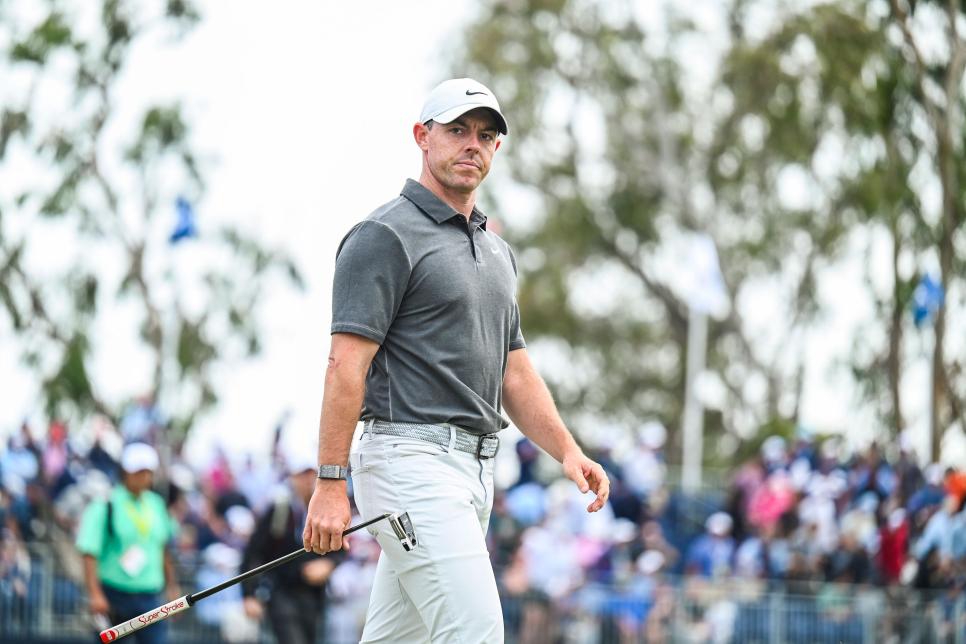
If you think Rory McIlroy’s blow up outside the clubhouse at Marco Simone late Saturday at the Ryder Cup in Italy is out of character for the generally even-keeled Northern Irishman, then you’re forgetting his angry shirt-ripping exhibition following the 2021 DP World Tour Championship. Yep, he’s the same guy who for more than a year has been the de facto spokesman for the PGA Tour in its battle against the LIV Golf League. McIlroy has carried a lot of water for the tour, and while he didn’t formally step down from the tour’s Policy Board until December, it became apparent as early as the PGA Championship in May that he had had enough and needed to concentrate on his golf. At 34, and stuck on four major titles since he won the 2014 PGA, McIlroy recognized a reset was necessary after missing the cut at the Players and the Masters, the latter being his elusive final piece to claim the career Grand Slam. However, he was thwarted yet again the rest of the major season, most notably in the U.S. Open, where a late bogey relegated him to second behind Wyndham Clark. He did win the Race to Dubai title for the fifth time on the DP World Tour and went 4-1 to help Europe avenge its crushing 2021 Ryder Cup defeat. A verbal altercation with Patrick Cantlay’s caddie Joe LaCava on the 18th green at Marco Simone amid that lone defeat in four-ball is what set off McIlroy on a profanity-laced tirade later that evening in the car park (Jim “Bones” Mackay the unwitting victim with no other American around). It might serve Rory well to bring that kind of heat to Augusta National in April. —Dave Shedloski
No. 5: Golf ball rollback

Rolling back distance has been in the crosshairs of golf’s governing bodies for at least the last two decades, but when a decision finally was announced in December, it seemed to catch most of the golf world by surprise.
Perhaps it wasn’t a shock that the USGA and R&A finally—or at least theoretically—were going to erase the distance gains seen at the elite levels of the game over the last 15 years. Both organization’s leaders, Mike Whan of the USGA and Martin Slumbers of the R&A, had made it clear over the last three years of joint reports and proposals on potential equipment rollbacks that the status quo on distance was not an option. No, the striking development on Dec. 6 was that golf’s rulemakers were taking aim at distance at every level of the game, that the rolled back ball would be the only ball that would be conforming for all of golf.
That decision came despite strong indications only months earlier that the universal directive from golf’s stakeholders was to do no harm to the recreational game. The initial plan, announced in March, was to institute what was known as a Model Local Rule that would apply only to the golf balls used for elite competitions. But outcry from several parties during the notice-and-comment period over what would essentially become a bifurcation of the rules caused the ruling bodies to reverse course and roll back golf ball performance standards for all golfers. Under the new rule, the USGA and R&A believe elite driving distance would be rolled back by 13-15 yards by changing the test speed for conforming golf balls from 120 miles per hour to 125 but keeping the distance limit the same. At the same time, the ruling bodies’ experts believe the effect of the change on average golfers’ driving distance would be minimal or non-existent.
What now? The reaction from most parts of the golf landscape, whether major manufacturers or major tours, was varying levels of disagreement mixed with equal parts a call for reconsidering the decision to grudging acceptance. Whether the rule goes through (it was announced that it would be phased in for elite players in 2028, then everyone in 2030) depends on how vociferous or litigious or disinterested various parties are in their relationship with the USGA and R&A.
Indeed, while legal challenges are one concern, there’s a potentially bigger fallout from the rollback that could also play out. With the tours and leading manufacturers already objecting to the logic behind the rollback decision, has it set in motion the possibility of golfers at all levels of the game disavowing the validity of the USGA and R&A? Would the PGA Tour set its own equipment standards? Would top manufacturers keep making nonconforming golf balls past the 2028 deadline or beyond 2030 because those balls are going to still be selling? Would regular golfers not only hoard the old balls but demand even faster ones? Would clubs and courses choose to play by old ball or new ball rules, sending visitors to the pro shop to restock before every round?
The big change may have been viewed as fundamentally necessary by the ruling bodies, but at this moment the effects of that decision seem anything but obvious. —Mike Stachura
No. 6: Jon Rahm
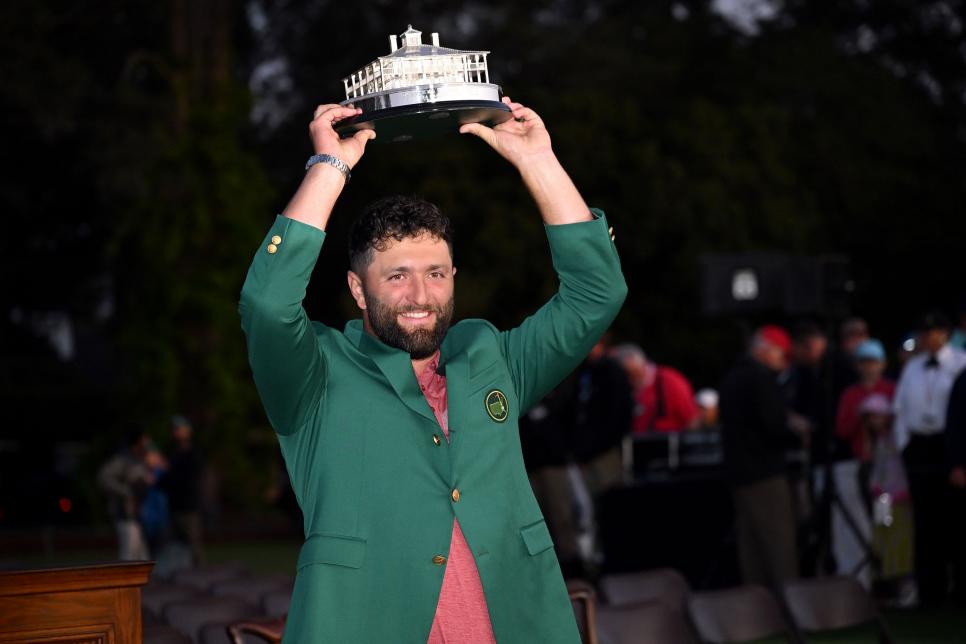
Let’s call it an eventful year, one Jon Rahm started and finished with (very different) bangs of significant magnitude. By the end of April, the burly Spaniard had already won four times on American soil, including the Masters, his second major championship title. Already, the race to be 2023’s Player of the Year looked over, especially as those four victories were surrounded by a brace of second places, a third and another top-10. It was a phenomenal, Tiger-like start to the opening third of 2023. Hang on though. Less than eight months later Rahm was suspended indefinitely from the PGA Tour in the wake of his signing with LIV Golf in a deal reported to be worth between $300 million and $600 million. That bombshell (albeit long rumored) did much to distract from what had been a relatively disappointing few months on the course for the 29-year-old. Following his victory at Augusta National, Rahm inevitably, and not surprisingly, slowed. There were no more wins other than a 12-way piece of Europe’s Ryder Cup triumph in Italy were recorded, although Rahm’s level of performance remained high. Two more top-10 finishes came along in majors. But even a T-2 finish in the Open Championship at Royal Liverpool bore a rather forlorn look, such was the dominance of six-shot winner Brian Harman. Still, any year that contains a major championship victory must be rated a success by any and every player, even one of Rahm’s financially beneficial stature. What 2024 will bring—other than piles of guaranteed cash—is likely to be another story entirely. Stay tuned. —John Huggan
No. 7: Brooks Koepka
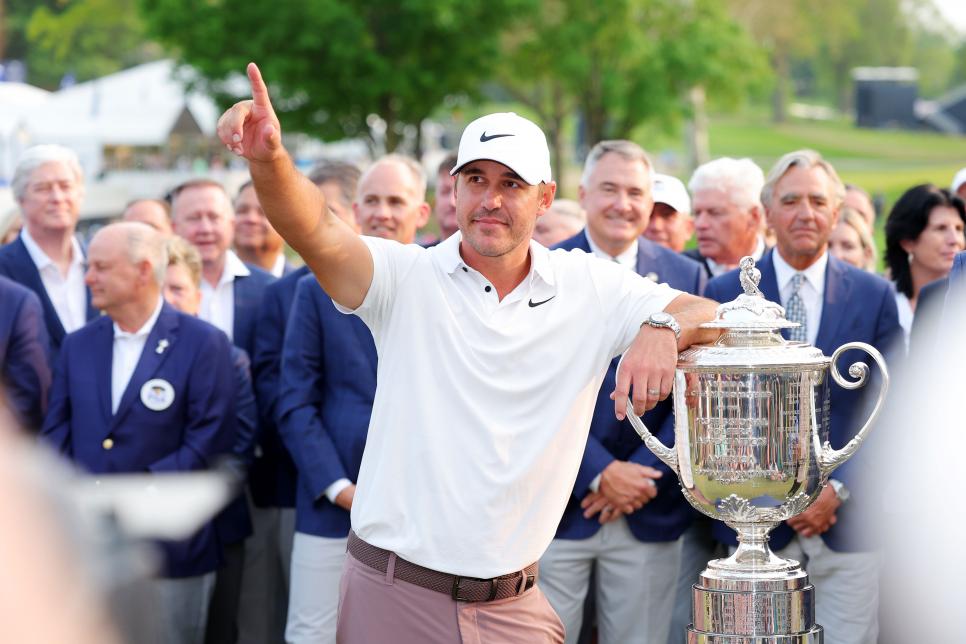
It’s crazy to think how different our perception of Brooks Koepka is now compared to the start of 2023. In January, when Netflix’s “Full Swing” golf docuseries was released, the Florida native was portrayed in a vulnerable light, a shocking contrast to the Alpha persona he had cast in the world of golf since winning the first of his (then) four majors in 2017. The streaming giant’s cameras showed an injured Koepka questioning his future in the game. But the narrative would begin to change back in late March, Koepka claiming a second career LIV Golf League victory in Orlando a week prior to the Masters. Once Koepka was at Augusta National, it was as if it was 2019 all over again. The former World No. 1 threatened to win the green jacket, succumbing to eventual champion Jon Rahm late Sunday who he was paired with in the final group, but hinting that something special was brewing. A little more than a month later, the 33-year-old paid it off, becoming the first LIV player to win a major when he claimed his fifth, and third PGA Championship victory, at Oak Hill.
Where Koepka’s inspired play in majors caused the most ruckus wasn’t in the PGA Tour vs. LIV civil war but rather in relation to the Ryder Cup, where LIV players weren’t entirely welcome. But Koepka essentially gave the U.S. team no choice, just missing out on an automatic qualifying spot while giving cover for Zach Johnson to take him as a captain’s pick. In Rome, Koepka went 1-1-1 in the Americans’ defeat. In October, Koepka won a third LIV title in Saudi Arabia to close out the year third on the season-long points list. His LIV drama included verbal sparring with Matthew Wolff, a member of his Smash GC team until trading him in December, and playful trolling of the PGA Tour, and even LIV itself on social media. Oh, and did we mention Brooks became a dad, too? We could go on, and we do right here with this separate post exploring 54 things that happened to Koepka in 2023, but the biggest thing was this: Brooksie was back to being the old Brooksie. —Evin Priest
No. 8: Scottie Scheffler
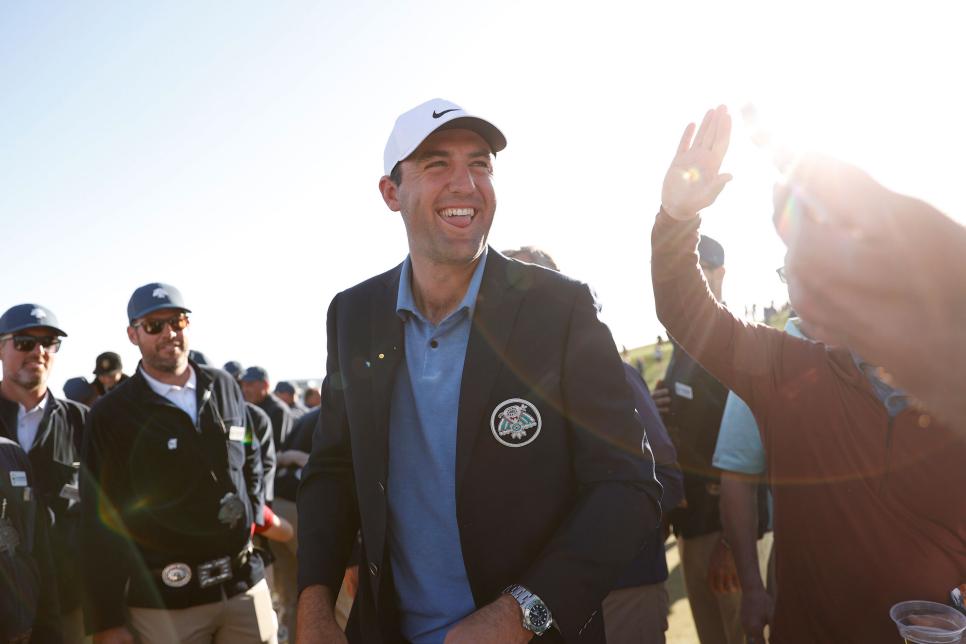
It’s weird to think that Scottie Scheffler won the Players Championship, pocketed a PGA Tour record $21 million and solidified his hold at the top of the World Ranking and somehow came away wanting. But that’s how it shakes out. The man was a ball-striking genius in 2023, leading the tour in all the meaningful categories (off the tee, tee to green, approach the green) that enabled him to finish 12th or better in 18(!) straight starts. Overall, in 23 tournaments, Scheffler had 14 top-five finishes, 17 top-10s and was among the top-25 all but twice. Starting with a T-5 at the AT&T Byron Nelson, the 26-year-old Texas native strung together seven consecutive top-fives … but no wins. And there’s the rub. Struggles with the putter—he ranked 155th in strokes gained—prevented Scheffler from a truly monster season. His only victory besides The Players was a successful title defense at the WM Phoenix Open. The summer ended with more frustration. For the second straight year he held the lead at the start of the Tour Championship and failed to win the FedEx Cup. Then came ignominy in the Ryder Cup, where Scheffler and Brooks Koepka were dealt a record 9-and-7 foursomes setback to Viktor Hovland, the FedEx champ, and rookie Ludvig Aberg. Scheffler sobbed in the aftermath. A late victory at the Hero World Challenge—with a new putter in the bag—proved some solace, and yet 2023 was, you could say, a far cry from the year he could have had. —Dave Shedloski
No. 9: Viktor Hovland
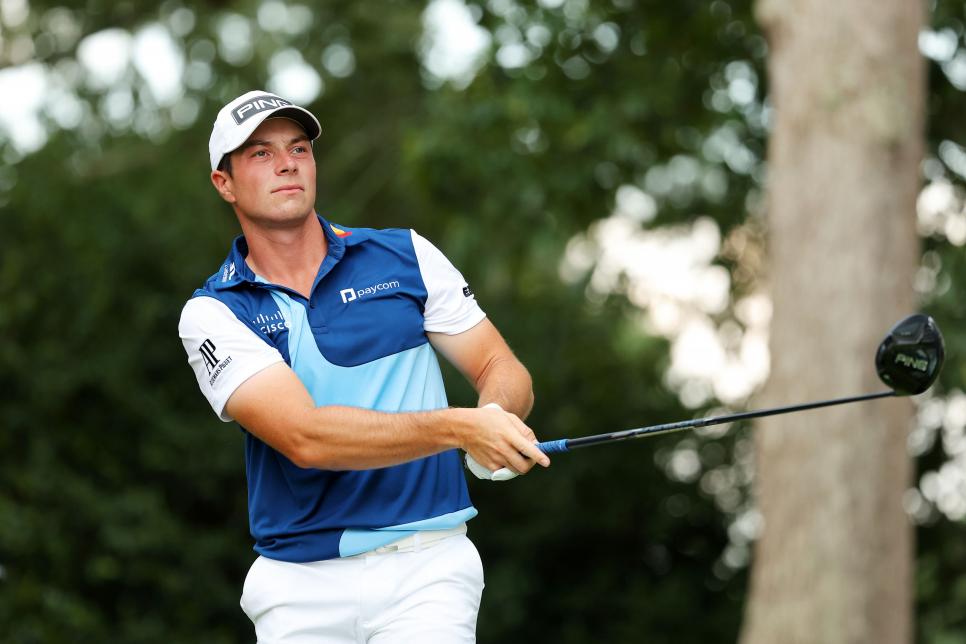
Ever since his impressive U.S. Amateur victory in 2018 at Pebble Beach, Viktor Hovland seemed clearly destined for big things. Mammoth drives, world-class ball-striking and a solid-ish putter are generally enough to win a lot in pro golf, and the young Norwegian checked all of those boxes. The final puzzle piece, though, was the short game, something the 26-year-old famously admitted he didn’t have much of a handle on after his very first PGA Tour victory at the 2020 Puerto Rico Open. “I suck at chipping,” Hovland said in the post-win interview, referring to a brutal chunk from that final round that somehow didn’t cost him the win. Ranking 191st in strokes gained/around-the-green in 2022 (after being 124th the previous season), led some to wonder if his short-game woes could ever be fixed. Turns out yes, after taking a practice-makes-perfect approach and getting back to basics with his coach Joe Mayo, who told our own Luke Kerr-Dineen in April to mark his words. “In a few months, he’ll be one of the best chippers in golf,” Mayo said. Hovland’s note entirely there yet, but he improved to 86th in SG/around-the-green in 2023, which promptly led to the career leap that had been previously predicted. Wins at the Memorial, the BMW Championship and the Tour Championship sealed his FedEx Cup title and allowed Hovland to once and for all shed his “Resort King” moniker in the process. The forecast now? How about multiple majors and possibly the title of World No. 1, in the near future for Hov. —Christopher Powers
No. 10: Rose Zhang

Dylan Buell
It had been as long as two decades since the pro debut of an amateur phenom—man or woman—had been as anticipated as Rose Zhang’s. Already a U.S. Women’s Amateur and U.S. Girls’ Junior champion, the 20-year-old Stanford sophomore claimed the Augusta National Women’s Amateur title in April then became the first repeat NCAA Women’s champion in May. What more was there to prove for the California native who has spent more weeks as the No. 1 amateur in the world (141) than anyone before her? Sure enough, the excitement became justified when Zhang made her maiden pro start at the Mizuho America’s Open on a sponsor’s exemption, and became the first player to win in her first LPGA appearance as a pro since 1951, defeating major champion Jennifer Kupcho in a playoff for the victory. If expectations were already sky high, now they were off the charts. Zhang eventually proved herself human—no, she wasn’t going to win every event she played in—but three top-10 finishes in majors during the summer allowed her selection by captain Stacy Lewis for the U.S. Solheim Cup team to feel more than deserved. So, what is realistic from Zhang in 2024? Multiple wins? A major title? Jumping to World No. 1? She’s 26th in the Rolex Rankings right now, seventh best among American women, and she’s still just six months into her career. There’s no rush at this point, as Zhang herself is acknowledging by deciding to continue her college education this spring while also competing on tour. The beginning of her pro career was electric. But that’s all it was: just the beginning. —Keely Levins
No. 11: PGA Tour's 'designated' events
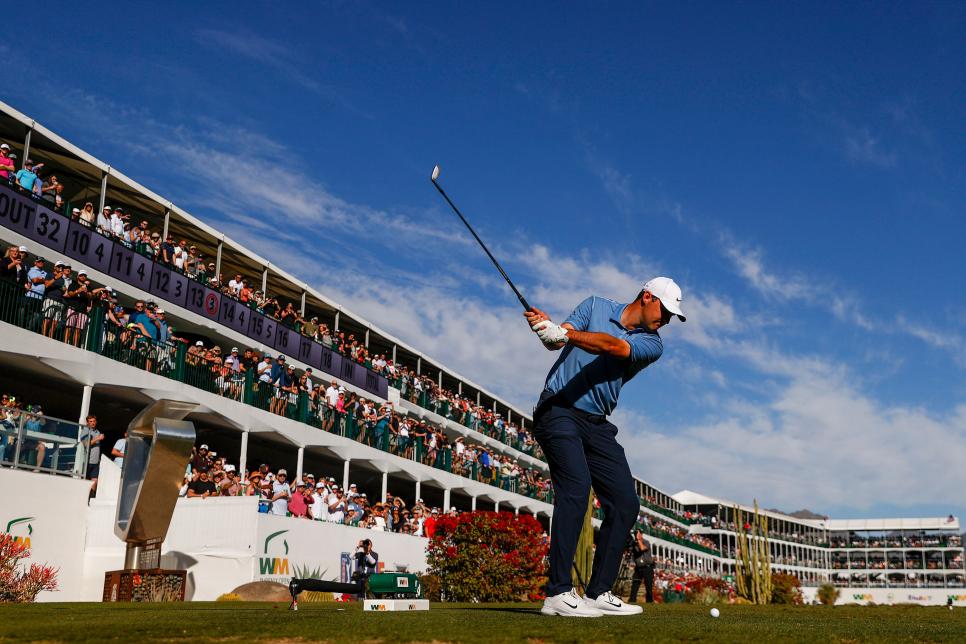
Even die-hard golf fans might not appreciate the fact that the PGA Tour didn’t first launch the idea of “designated” events in 2023. Back in 1974, tour officials gave the label to four tournaments, including the inaugural Tournament Players Championship (now known as The Players), and leaned on winners from the previous season and some other top players to appear or face “stiff penalties.” There were just two events in 1975, and after that they went away, only to be revived this past season, this time to reward star players who might be tempted to desert in favor of the LIV Golf League. Purses in these events were bumped up to $20 million—$25 million for The Players—and participation was mandatory for the elite in all but one event of their choosing or they would forfeit bonus money from the Player Impact Program. Only one player opted out for more than one event; ironically, it was Rory McIlroy, a leading proponent of the designated events model. Carrying a new label of “signature” events for 2024, the series will feature limited fields and no cut to further ensure payoffs for the already well off. Kind of a shame when designated events in 2023, with full fields, produced loaded leaderboards, marquee winners like Jon Rahm (twice), Scottie Scheffler (above at the WM Phoenix Open) and Viktor Hovland as well as great stories like Kurt Kitayama at the Arnold Palmer Invitational, Keegan Bradley at the Travelers and Matt Fitzpatrick’s playoff victory over Jordan Spieth at the RBC Heritage. Changing the formula for the coming year has the potential of looking myopic as the new season rolls on. We shall see. —Dave Shedloski
No. 12: Michael Block

With a certain 47-year-old legend sidelined for the PGA Championship (yes, we missed you Tiger Woods), a 46-year-old club professional captivated golf fans across the country instead. Michael Block morphed from a fun early-week underdog story into an actual contender entering the weekend at Oak Hill. But what he did on Sunday seemed even too unlikely for a Hollywood script as he made the tournament’s lone ace—a slam-dunked 7-iron in the presence of Rory McIlroy—then made a ridiculous up-and-down par on the final hole to earn a spot in next year’s PGA. That performance, plus a plethora of viral moments, got him spots in various other PGA Tour events as well. He wouldn’t find quite the same success anywhere else, although he finished T-27 at the Australian Open earlier this month and won the Southern California PGA Player of the Year for a ridiculous 10th time in 11 years. Eventually, the Internet turned some on the Arroyo Trabuco teaching pro—largely from a comment that he’d be “one of the best players in the world” if he had McIlroy’s length—but most of that hate seemed to come from those upset that Block’s 15 minutes of fame extended the entire summer and fall. From our perspective, we were happy to follow “Blockie” and his wild ride, complete with wild recovery shots, brushes with celebrities, a ninth(!) career albatross, and a new course record at Valhalla, which just happens to be the site of the 2024 PGA. We look forward to seeing you there, Michael. —Alex Myers
No. 13: Talor Gooch

It’s hard not to focus on prize money when discussing Talor Gooch and his three-win breakthrough LIV Golf League season because, well, he won A LOT of it … $36.2 million, to be exact. There was $18 million made on the course as Gooch won events in Australia, Singapore and Spain while also registering five top-10 finishes in 13 starts. (By comparison, in 122 career starts on the PGA Tour, Gooch made $9.2 million.) Finishing atop of the season-long individual points list ahead of former Open champion Cameron Smith, Gooch also claimed the league’s year-end $18 million bonus. It’s worth noting that he plans to spread some of the wealth to his Talor Gooch Foundation in Oklahoma, which has a focus on children, homelessness and junior golf.
OK, enough about money. The 32-year-old also generated headlines in April when he brought to light a tweak by the USGA with an exemption into the U.S. Open. Where previously the top 30 who qualified for the PGA Tour season’s Tour Championship earned entry into the major (and did so at this year’s Masters and PGA Championship), the qualifying category for 2023 now read “qualified and eligible.” The subtle change, which only impacted Gooch, meant that while had earned enough FedEx Cup points earlier in the 2021-22 PGA Tour season to qualify for East Lake, because he was banned by the tour for bolting to LIV, thus not eligible to play in the FedEx Cup finale, he would have to figure out another way to get into the field at Los Angeles Country Club. Gooch passed on entering Final Qualifying.
Despite his success on the LIV circuit, with those events not earning World Ranking points, Gooch has slid quite a ways down the OWGR list, falling from a career-high of No. 31 to No. 298. To get into any of the four majors in 2024 via the World Ranking, of which he’s currently qualified for none, he will likely need to add Asian Tour or DP World Tour events to his early 2024 schedule. “Of course, I want to play in all the majors; if qualifying is one of the routes, that’s something I’ll look at,” he said. Gooch hopes the majors soon figure out a way to include LIV golfers in their fields. “We all want to have a pathway to the majors within LIV, whether that's the World Rankings or in some other capacity.” —Evin Priest
No. 14: Lilia Vu

Lilia Vu’s 2023 season was one to remember: a four-win campaign in which she became only the fourth American to hold the No. 1 spot in the Rolex Women’s Rankings and the first to earn LPGA Player of the Year honors since 2014. Chances are, it would have made her paternal grandfather proud. In 1982, 15 years before the Fountain Valley, Calif., native was born, Dinh Du spent months building a boat in war-torn Vietnam to get his family and others out of the country, setting up the life Vu would enjoy. After his passing in 2020, his inspiring story continues to motivate Vu. "Even when I get down on myself, I kind of think, ‘OK, Grandpa didn't do all this for you to get upset over one shot.’” Vu's world-beating efforts are also notable considering the state of her game just four years ago; the then LPGA rookie made one cut in nine starts in 2019, losing her card and causing her to contemplate leaving the game to go to law school. Consider, though, all the 26-year-old would have missed out on: Vu earned her first LPGA career victory in her opening start of 2023 at the Honda LPGA Thailand. A victory in April at the Chevron Championship, played for the first time at its new home in The Woodlands, Texas, made her a major champion. Less than four months later, she was a multiple-major winner with a victory at the AIG Women's Open. Vu then played hard through the fall, posting top-five performances, including one last win at The Annika, in her final four starts to pass Celine Boutier in the POY race. "Last year I played golf with a lot of worry," Vu said. "I just was worried about everything. When you're worried about making the cut you tend to miss the cut, but if you try to win the tournament you will be fine and won't miss the cut." What Vu has learned in facing all her golf “what-ifs” should have the rest of the LPGA on notice in 2024. And it should, indeed, make grandpa proud. —Kent Paisley
No. 15: Tiger Woods

It was another disappointing year health-wise for Tiger Woods, who wound up playing only six full rounds in 2023 before withdrawing during the third round of the Masters. But there’s optimism heading into 2024 after the 15-time major winner had subtalar fusion surgery on his right ankle in April and returned seven months later at the Hero World Challenge. While Woods only finished 18th in the 20-man field, he was pleased with his progress, especially off the tee where he showed a surprising amount of pop for a guy about to turn 48 with two parts of his body fused together. More importantly, he felt good enough after walking 18 holes for four consecutive days to say he hopes to play on a monthly basis in 2024. Woods was busy in other ways, though, becoming a member of the PGA Tour Policy Board in August after the tour’s surprise announcement that it had entered into a framework agreement with Saudi Arabia’s Public Investment Fund. And he became a regular caddie for his son, Charlie, even getting to witness the 14-year-old help lead his high school team to a state championship. The two will team up for a fourth consecutive year at the PNC Championship, an event Woods says he looks forward to “more than anything.” Golf fans feel similar about the prospect of a healthy Tiger playing more regularly in the new year. —Alex Myers
No. 16: Brian Harman
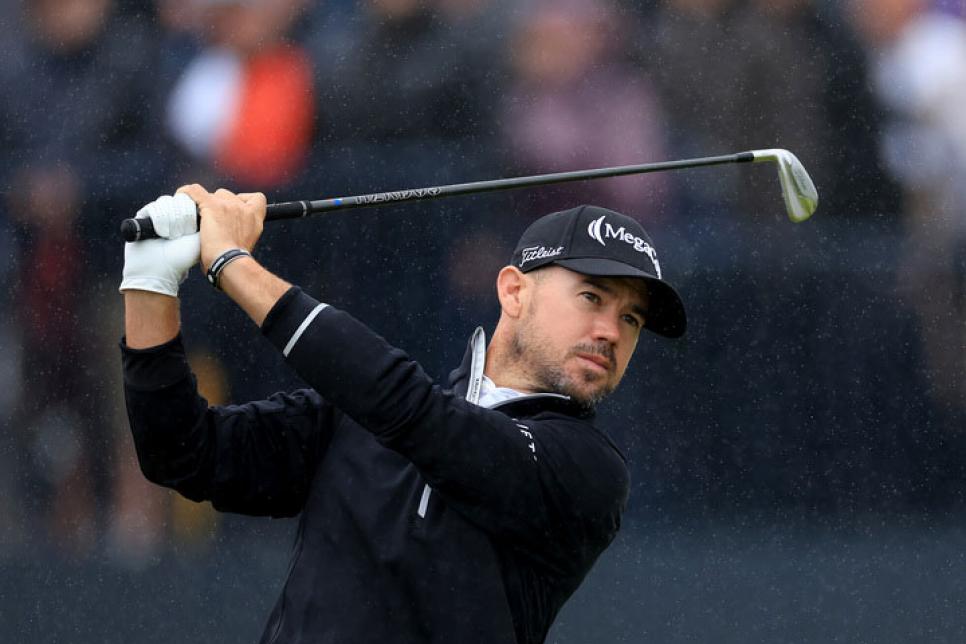
Ahead of the Open Championship at Royal Liverpool, Brian Harman was listed at 150-1 to win by the oddsmakers, an indicator that the 36-year-old PGA Tour veteran was given little chance at victory despite having just collected three consecutive top-12 finishes, including one the week prior at the Genesis Scottish Open. As Harman went on to prove, counting him out is exactly how he likes it. The diminutive lefty has dealt with quips about his size throughout his career, and he often reacts in a manner that reveals he doesn’t very much appreciate them. Time and time again, though, he has proven what he lacks in size he makes up for in heart, a trait on full display when he poured in clutch putt after clutch putt on Sunday at Hoylake en route to his third PGA Tour title and first major championship. Dubbed “The Butcher” by the British tabloids for his love of big-game hunting, it wasn’t all that different from what he did to the likes of Rory McIlroy and Jon Rahm that week at Hoylake. You could count with two hands the number of people on property who believed Harman could win as he started his final 18 holes, and some of those who didn’t believe let Harman know it with heckles that accompanied him around Hoylake. But in closing out his six-shot romp, Harman got in the last word. For his efforts, he was also selected to the U.S. Ryder Cup team, where he went 2-2-0 as a rookie while American stalwarts like Scottie Scheffler, Xander Schauffele and Rickie Fowler failed to win a single match collectively. Big-game hunter and the butcher are fine nicknames, but one label we should absolutely attach to Harman is this—a certified dog. —Christopher Powers
No. 17: Viral golf fights

Can’t we all just get along? Sadly, the answer is a resounding no, even on the golf course. From coast to coast and well beyond, it seemed on-course fight videos popped up—and spread—on a weekly basis. In one recording of a tee box brawl at a Lakeland, Fla., muny, the person filming even exclaimed, “Dude, we could go viral.” And that’s exactly what happened, even with TikTok taking down the video after it racked up more than one million views in a couple days due to a “violence guideline violation.” But there would be plenty more, from a vicious knockout punch in Springfield, Ill., to some dads accidentally picking a fight with some former MMA fighters in Owasso, Okla., to whatever this shirt-ripping guy was trying to prove in Ottawa Lake, Mich. As we examined in the November issue of Golf Digest, these incidents that often stem from slow play, gambling and, of course, alcohol, are nothing new, but modern technology has made them much easier to be seen by the masses. That’s not changing anytime soon. And neither is the fact that golf fans can’t seem to get enough of these on-camera tussles. Just remember, it’s better to watch one of these videos than to be a part of one. Stay safe out there, folks. —Alex Myers
No. 18: U.S. Women's Open at Pebble Beach

Without argument, it was the most anticipated U.S. Women’s Open in the championship’s 78-year history. For the first time, the best female players in the world were tasked with tackling the storied Pebble Beach Golf Links in the national championship. With so much USGA history made on the Monterey Peninsula—just say Nicklaus, Watson, Woods to conjure indelible memories—there was a deep desire among all in the 156-woman field (from a record 2,107 entries) to be the first to hoist the U.S. Women’s Open trophy on Pebble’s famed 18th green.
Under overcast skies on the second Sunday in July, it was straight-hitting Allisen Corpuz who secured those bragging rights, along with a record $2 million first prize. The 25-year-old USC product, a native of Hawaii in her second year as a professional, closed with a three-under-par 69 to win her first LPGA title by three shots over hard-charging Englishwoman Charley Hull, whose closing score of 66 tied for week’s best round. Corpuz had worked since early in the season on her self-belief. "I think I've just played a little conservatively in the past, and just really went out there and told myself I had the game to do it today,” she said.
If there was any question about how the women might handle Pebble’s grabby rough and small greens, Corpuz’s winning score of nine-under 279—only four shots off the record U.S. Open mark Gary Woodland set there in 2019—proved they were up for the challenge. Pebble Beach did, however, take a bite out of some of the game’s most recognizable players. World No. 1 Jin Young Ko opened with a 79 and missed the cut by one shot. Lexi Thompson and Danielle Kang also struggled and didn’t make the weekend.
The USGA’s excitement about going to Pebble Beach was due in large part to the audience reach it would have among both established golf fans and curious viewers, thanks to primetime TV slots in the East. The numbers didn’t disappoint, with the final round on NBC earning a peak viewership of 2.2 million—the best since Michelle Wie won the 2014 edition at Pinehurst.
It was a full-circle circumstance in one way. Wie West and three-time U.S. Women’s Open winner Annika Sorenstam, took their final bows in the major on Friday afternoon when they missed the cut while playing together. With her flair for the dramatic, Wie West drained a 30-foot putt on the 18th hole to rousing cheers, and Pebble Beach produced yet another cherished moment. —Tod Leonard
No. 19: Bryson DeChambeau's 58
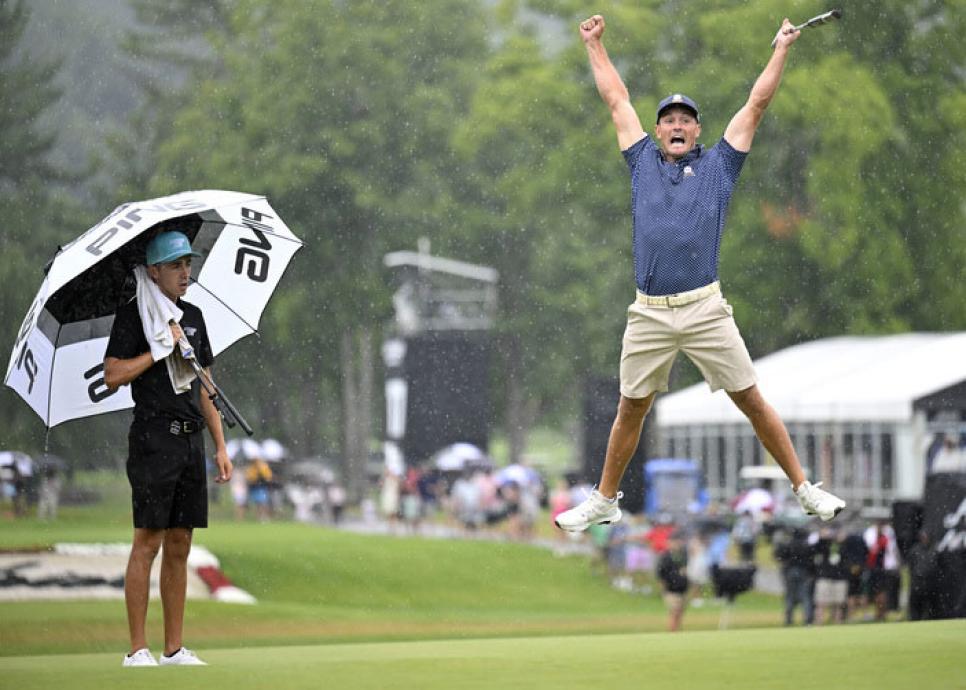
Bryson DeChambeau was not short off the tee, nor short on headlines in 2023. In a nutshell, he won twice on LIV Golf, shot the fourth 58 ever recorded on a top tour, called out the Official World Golf Rankings board and used a driver common among long-drive competitors to blast his tee shots into orbit.
In August, the former U.S. Open champion won for the first time since joining the upstart circuit at a former PGA Tour host course, the Old White at Greenbrier. In the final round, he carded 13 birdies and a bogey for a stunning 12-under-par 58 (an accomplishment he soon capitalized on, literally, with a line of merch commemorating the feat). A month later, he won another LIV event in Chicago. Coupled with some form in the majors, including a T-4 at the PGA Championship at Oak Hill and a T-20 at the U.S. Open at LACC, DeChambeau had something of a case for a 2023 Ryder Cup captain’s pick, though he never got the call from Zach Johnson to meet the Americans in Rome.
Still, the 30-year-old Californian wasn’t afraid to turn back the clock, producing drives that made him famous on the PGA Tour, like when he attempted (and nearly succeeded) to drive the green at the par-5 sixth at Bay Hill in 2021 during his eighth and most recent PGA Tour win. In 2023, DeChambeau deployed a Krank driver, used by world long drive champions, and hit multiple drives longer than 380 yards on LIV, including a league-leading 14 drives of 350 yeards or deeper.
For over, the former World No. 4 also created a different genre of headlines by embodying the dilemma professional golf: How does the game accurately rank all the top players now that plenty have left the PGA Tour for LIV? For example, DeChambeau’s 58 at LIV Greenbrier, as Datagolf.com noted, was only the 328th best round of all time per true strokes gained analytics, adjusting for the strength of field. The field average during DeChambeau’s 58 was 66.74.
The riddle stems from the fact LIV does not award Official World Golf Ranking points for its events (its application for OWGR points was rejected in October). DeChambeau created more news at the time of the rejection, when he proposed a solution to the diminishing pathways for LIV players into golf’s four majors, which all use the OWGR as part of their criteria. “Top 12 on the [LIV Golf] money list, at the end of the year or the points list, would be I think obvious for the major championships to host the best players in the world at those four events each year,” he said.
The old Byrson DeChambeau was back, longer and louder than ever. —Evin Priest
No. 20: OWGR vs. LIV Golf
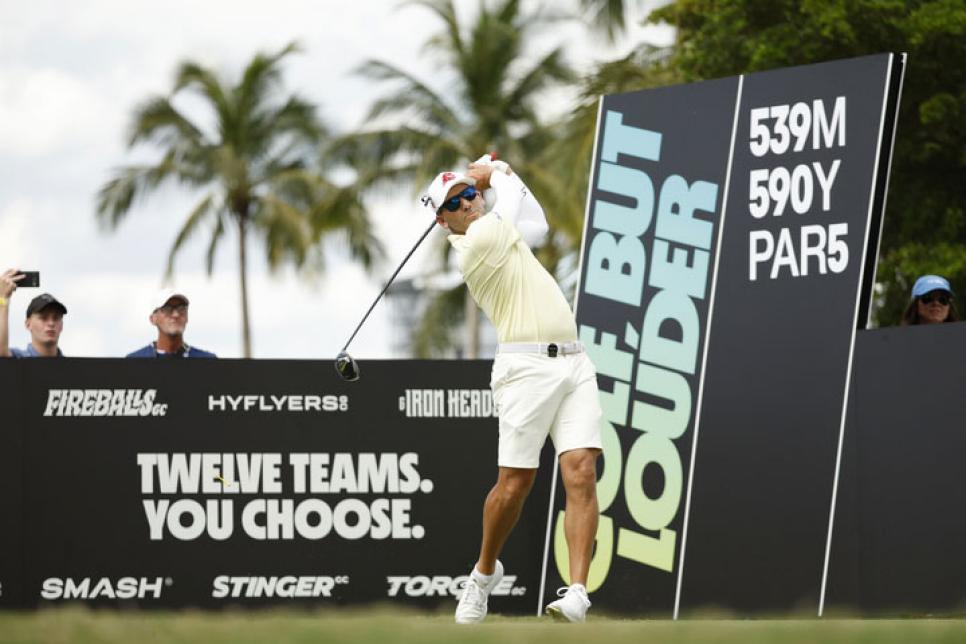
Almost as soon as it came to be in 1986, the Official World Golf Ranking was accompanied by critics. But no individual or body has had less good to say about the system aims to measure performance in the men’s professional game than those running the LIV Golf League. And on that front at least, nothing changed in 2023. With its 54-hole, no-cut, shotgun-start format, and an accompanying team component, LIV continues to fall short of many of the rules used for inclusion in the OWGR. In October, 15 months after LIV Golf formally applying for its events to receive World Rankings points, OWGR chair Peter Dawson wrote to LIV chief executive Greg Norman and COO Gary Davidson stating that “at this time” the Saudi-backed circuit will not be recognized as an “Eligible Golf Tour.” Said Dawson: “The committee remains concerned about the implications of conducting individual and team competitions simultaneously,” before further citing the limited access for players to join LIV. The news wasn’t what Sergio Garcia (above), who was 55th in the world at the time of LIV’s inaugural event in June 2022 and is now 483rd, or his fellow LIV golfers wanted to hear. With its players plummeting down the OWGR—thus hindered from using the ranking as a method to qualify for the four men’s majors—it’s no surprise the anger and frustration LIV officials offered in response: “Professional golf is now without a true or global scoring and ranking system. There is no benefit for fans or players from the lack of trust or clarity as long as the best player performances are not recognized.” And so it goes on. —John Huggan
No. 21: "Full Swing"

The moment rumors began to swirl that Netflix was bringing its massively successful template from the Formula 1 documentary "Drive to Survive" to the world of professional golf, anticipation began to build. When "Full Swing" finally hit the streaming platform in mid-February with its eight-episode first season, that anticipation gave way to intense discourse (including our own episode-by-episode podcast review): Was it fair? Was it accurate? Was it good? Those debates will rage on—personally, I thought the show was occasionally great, occasionally disappointing, with the Joel Dahmen episode standing out as the one truly superlative piece of TT. But there's no argument about the show's success: they killed it. Not only did it reach No. 2 in the U.S. and U.K. in the Netflix rankings (and top 10 worldwide), but there was clear evidence that it translated into increased viewership for the PGA Tour. Within a couple weeks, the streaming giant greenlit a second season, and in a year of unprecedented strife in the professional game, it's no exaggeration to call "Full Swing" the best piece of news golf could possibly get. When it seems like circumstances are aligning to alienate the average fan in a self-defeating process, a popular documentary provides the best kind of antidote. Whether you're Jay Monahan or Keith Pelley or Yasir Al-Rumayyan, you have to hope it continues for years. —Shane Ryan
No. 22: Phil Mickelson
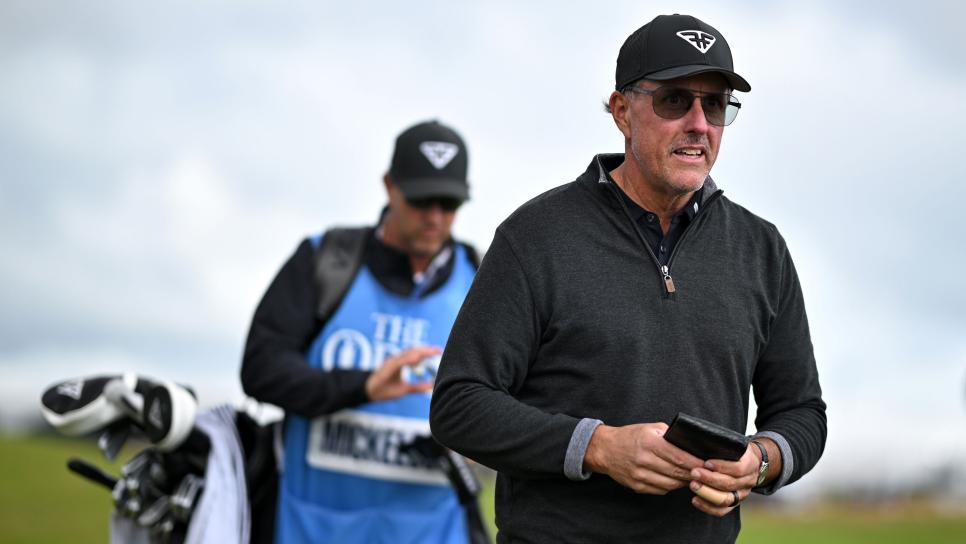
Charlie Crowhurst/R&A
At 53, Phil Mickelson remains an attraction, even if he plies his trade predominantly on the LIV Golf League, which after two years still struggles to gain traction with golf fans. It’s certainly not for his golf—or, more accurately, his golf in 54-hole events. Let’s be honest: LIV is populated by little more than a dozen world-class, in-their-prime talents (although that appears to be changing), and yet Mickelson finished 39th in the points standings with just one top-10 finish (10th at Bedminster). In contrast to that, the six-time major winner submitted an inspired performance in the Masters, finishing tied for second thanks to a closing seven-under 65. When the left-hander does make news these days, it’s off the course, whether its railing against the PGA Tour on social media or for alleged past sins coming to light, specifically the allegation by noted gambler Billy Walters in a tell-all autobiography that Mickelson sought to bet on the 2012 Ryder Cup. Mickelson denied, via X/Twitter, betting on the Ryder Cup—without addressing whether or not he looked into it. Phil always has been outspoken. Just ask Tom Watson. Bet that doesn’t change, which means he’ll remain a compelling figure in the game. —Dave Shedloski
No. 23: Ludvig Aberg

Alex Slitz
Ridiculous. That might be the only way to describe the body of work Ludvig Aberg has accumulated in just six months as a professional golfer. Most notably, an impressive—and winning—Ryder Cup debut for Europe (going 2-2) was bookended by victories on both the DP World Tour (Omega European Masters) and the PGA Tour (RSM Classic). In those feats alone, the 24-year-old Swede by way of Texas Tech (where he graduated in June and earned immediate PGA Tour status through his top ranking in the PGA Tour University program) has accomplished more than many do in careers decades-longer. It is, by any measure, already a phenomenal record of achievement at the highest level. In his 13 starts on the PGA Tour, Aberg ranked second in strokes gained/off the tee and 10th in strokes gained/tee to green, showing plenty of talent and few nerves in making the transition to the pro game. A host of enticing items surely remain on Aberg’s to-do list. Not least will be a major championship victory. Remarkably, the former World No. 1 amateur has yet to play in any of golf’s four most important events. That changes in April at Augusta National, and his No. 32 spot in World Ranking will get him into the other three. Judged solely on his play so far, it will come as something short of a shock if Aberg does not at least contend in the Masters and if not the other legs of the men's Grand Slam. Of course, only the inexorable passing of time will reveal with certainty just how good Aberg really is. But oh my goodness the early signs are that we may have the next superstar on our hands. —John Huggan
No. 24: Bernhard Langer

Patrick McDermott
It appeared inevitable that Bernhard Langer, remaining supremely fit and incomparably driven to excel well into his 60s, would pass Hale Irwin’s record of 45 PGA Tour Champions titles in 2023. He could simply pick off a few 54-hole events, just as he did in February at the Chubb Classic, where he won for the fifth time to tie Irwin’s mark. A 72-hole senior major was supposed to be too big of an ask. When he arrived at the U.S. Senior Open in July at punishing SentryWorld, the German wonder, a month shy of 66, downplayed his chances. “They're going to hit driver/9-iron [into the greens]. I'm hitting driver/3-iron, which makes it hard to compete when you do that 72 times,” Langer said. “I know I have to play at my highest level to have any hope to win.” When 72 holes were completed, Langer had beaten senior golf’s most dominant player, Steve Stricker, by two strokes in Stricker’s home state of Wisconsin. It wasn’t just a record-breaking performance, but also one that defined who the two-time Masters champion is as a competitor. If he never wins again, the victory stands as one of the great cappers to a career. —Dave Shedloski
No. 25: Books
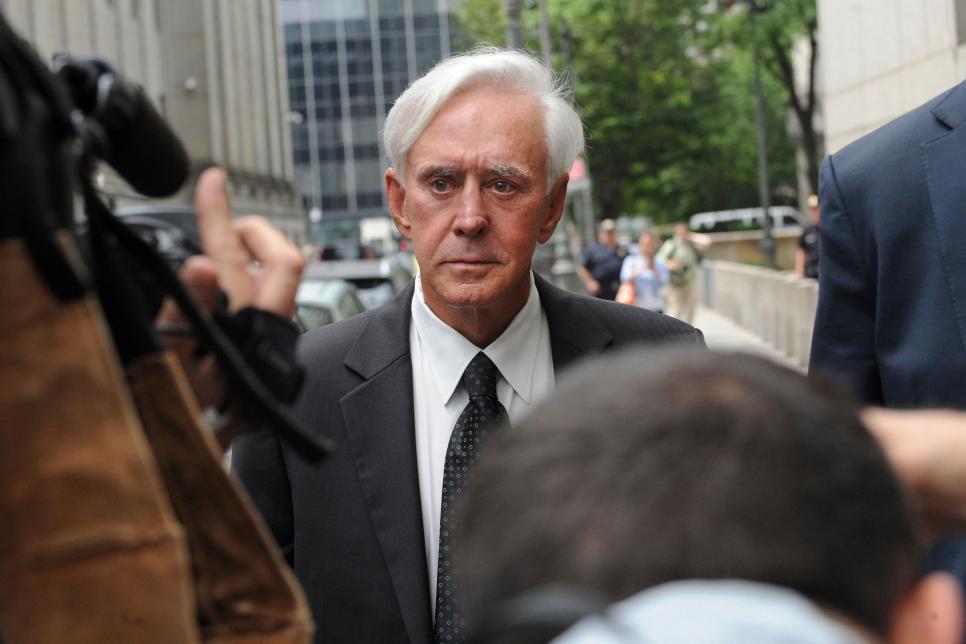
Bloomberg
They were the two most anticipated books among golfers in 2023, and neither was going to be particularly flattering to the professional game. In August, convicted inside trader Billy Walters published Gambler: Secrets from a Life at Risk about his notorious path as a legendary high-stakes gambler. The anticipatory buzz in golf was palpable because of Walters’ close relationship with Phil Mickelson, and in that regard, he did not disappoint. Walters wrote about their friendship, partnership in offshore gambling and ultimately their bitter falling out over the conviction that got Walters (above) a prison sentence.
There were sizable bombshells, the first being that Walters said Mickelson asked him to place a $400,000 wager on the U.S. team to win the 2012 Ryder Cup in which he was playing. (Walters wrote that he was shocked and declined to make the bet, and Mickelson denied after the book was published that he made the wager.) Secondly, Walters alleged that Mickelson wagered more than $1 billion over three decades and suffered more than $100 million in gambling losses. Whoa. “Phil liked to gamble as much as anyone I’ve ever met,” Walters wrote. “Frankly, given Phil’s annual income and net worth at the time, I had no problems with his betting. And still don’t. He’s a big-time gambler, and big-time gamblers make big bets. It’s his money to spend how he wants.”
Two months after the Walters book, Alan Shipnuck published his second compelling golf book in 17 months, with Liv and Let Die following his 2022 unauthorized biography of Mickelson. Shipnuck detailed the rise of LIV and the shock waves it sent through the professional game—again, with a muckraking factor that was off the charts. Mickelson again is a featured character as he seemingly exacts his revenge on the PGA Tour by scheming to make LIV come to life.
In a review, Golf Digest’s Shane Ryan concluded, “Shipnuck tells a good tale, but it's not a particularly uplifting one, and you can see why he leaves the ugly conclusion for the end. We might have been blinded by the dramatic twists and turns along the way, but this saga was written in stone from the very beginning. And even though Shipnuck's book was published before the resolution, the lack of closure doesn't matter: We already know the ending.”
Or do we? That’s the kind of year it’s been. —Tod Leonard


